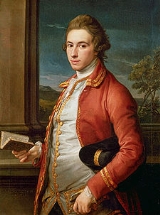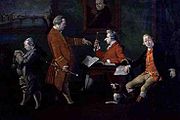
Sir William Fitzherbert, 1st Baronet
Encyclopedia
Sir William FitzHerbert, 1st Baronet (1748–1791) was the first baronet Fitzherbert of Tissington
. He was a lawyer and recorder for Derby
. He was an usher to George III. He owned a number of plantations for sugar and coffee in Jamaica and Barbados.
. He attended Westminster School
and St John's College, Cambridge
, graduating M.A. in 1770. He toured Europe
with his neighbour William Cavendish
, later fifth Duke of Devonshire
, when they were both about twenty. After leaving Paris
they visited the major cities of Italy, including Rome
and Florence
, where Fitzherbert commissioned portraits of himself and his companion from Thomas Patch
and Pompeo Batoni
respectively.
 He served as Gentleman Usher
He served as Gentleman Usher
to King George III
and was rewarded with portraits of the king and queen. On 14 October 1777 he married Susan Perrin in London and through her inherited five plantations in Jamaica. These were four sugar plantations of Blue Mountain, Forest, Grange Hill and Vere and the coffee plantation of Retrieve Mountain.
Fitzherbert became a baronet on 22 Jan 1784 and retired to the family seat of Tissington Hall
. On his death in 1791 he was buried at Tissington and was succeeded by Anthony Perrin Fitzherbert his son with Susan, his wife. His younger brother Alleyne FitzHerbert
was a diplomat who became a baron
in 1791.
Anthony Fitzherbert, the second baronet, died suddenly on 2 April 1798 of a "sudden consumption" at the age of nineteen. He was succeeded by Henry, his brother, the third son of the first baronet.
Fitzherbert Baronets
The FitzHerbert Baronetcy, of Tissington in the County of Derby, is a title in the Baronetage of Great Britain. It was created on 22 January 1784 for William FitzHerbert, of Tissington Hall, Derbyshire. The FitzHerberts descend from Norman knights and from the 12th century FitzHerberts of Norbury...
. He was a lawyer and recorder for Derby
Derby
Derby , is a city and unitary authority in the East Midlands region of England. It lies upon the banks of the River Derwent and is located in the south of the ceremonial county of Derbyshire. In the 2001 census, the population of the city was 233,700, whilst that of the Derby Urban Area was 229,407...
. He was an usher to George III. He owned a number of plantations for sugar and coffee in Jamaica and Barbados.
Biography
Fitzherbert was born 27 May 1748 to William and Sarah Fitzherbert of Tissington HallTissington Hall
Tissington Hall is an early 17th century Jacobean mansion house situated at Tissington, near Ashbourne. Derbyshire. It is a Grade II* listed building....
. He attended Westminster School
Westminster School
The Royal College of St. Peter in Westminster, almost always known as Westminster School, is one of Britain's leading independent schools, with the highest Oxford and Cambridge acceptance rate of any secondary school or college in Britain...
and St John's College, Cambridge
St John's College, Cambridge
St John's College is a constituent college of the University of Cambridge. The college's alumni include nine Nobel Prize winners, six Prime Ministers, three archbishops, at least two princes, and three Saints....
, graduating M.A. in 1770. He toured Europe
Grand Tour
The Grand Tour was the traditional trip of Europe undertaken by mainly upper-class European young men of means. The custom flourished from about 1660 until the advent of large-scale rail transit in the 1840s, and was associated with a standard itinerary. It served as an educational rite of passage...
with his neighbour William Cavendish
William Cavendish, 5th Duke of Devonshire
William Cavendish, 5th Duke of Devonshire, KG was a British aristocrat and politician. He was the eldest son of the William Cavendish, 4th Duke of Devonshire by his wife the heiress Lady Charlotte Boyle, suo jure Baroness Clifford of Lanesborough, who brought in considerable money and estates to...
, later fifth Duke of Devonshire
Duke of Devonshire
Duke of Devonshire is a title in the peerage of England held by members of the Cavendish family. This branch of the Cavendish family has been one of the richest and most influential aristocratic families in England since the 16th century, and have been rivalled in political influence perhaps only...
, when they were both about twenty. After leaving Paris
Paris
Paris is the capital and largest city in France, situated on the river Seine, in northern France, at the heart of the Île-de-France region...
they visited the major cities of Italy, including Rome
Rome
Rome is the capital of Italy and the country's largest and most populated city and comune, with over 2.7 million residents in . The city is located in the central-western portion of the Italian Peninsula, on the Tiber River within the Lazio region of Italy.Rome's history spans two and a half...
and Florence
Florence
Florence is the capital city of the Italian region of Tuscany and of the province of Florence. It is the most populous city in Tuscany, with approximately 370,000 inhabitants, expanding to over 1.5 million in the metropolitan area....
, where Fitzherbert commissioned portraits of himself and his companion from Thomas Patch
Thomas Patch
Thomas Patch was an English painter, engraver and caricaturist. He made a living by basing himself in Italy and undertaking commissions from rich young British men on Grand tours. His paintings today are in the Royal Collection and various museums. Patch was thrown out of Rome probably for a...
and Pompeo Batoni
Pompeo Batoni
Pompeo Girolamo Batoni was an Italian painter whose style incorporated elements of the French Rococo, Bolognese classicism, and nascent Neoclassicism.-Biography:He was born in Lucca, the son of a goldsmith, Paolino Batoni...
respectively.

Groom of the Chamber
Groom of the Chamber and Groom of the Privy Chamber were positions in the Royal Household of the English monarchy, the latter considerably more elevated. Other Ancien Régime royal establishments in Europe had comparable officers, often with similar titles...
to King George III
George III of the United Kingdom
George III was King of Great Britain and King of Ireland from 25 October 1760 until the union of these two countries on 1 January 1801, after which he was King of the United Kingdom of Great Britain and Ireland until his death...
and was rewarded with portraits of the king and queen. On 14 October 1777 he married Susan Perrin in London and through her inherited five plantations in Jamaica. These were four sugar plantations of Blue Mountain, Forest, Grange Hill and Vere and the coffee plantation of Retrieve Mountain.
Fitzherbert became a baronet on 22 Jan 1784 and retired to the family seat of Tissington Hall
Tissington Hall
Tissington Hall is an early 17th century Jacobean mansion house situated at Tissington, near Ashbourne. Derbyshire. It is a Grade II* listed building....
. On his death in 1791 he was buried at Tissington and was succeeded by Anthony Perrin Fitzherbert his son with Susan, his wife. His younger brother Alleyne FitzHerbert
Alleyne Fitzherbert, 1st Baron St Helens
Alleyne FitzHerbert, 1st Baron St Helens PC was a British diplomat and a friend of explorer George Vancouver, who named Mount St...
was a diplomat who became a baron
Peerage of Great Britain
The Peerage of Great Britain comprises all extant peerages created in the Kingdom of Great Britain after the Act of Union 1707 but before the Act of Union 1800...
in 1791.
Anthony Fitzherbert, the second baronet, died suddenly on 2 April 1798 of a "sudden consumption" at the age of nineteen. He was succeeded by Henry, his brother, the third son of the first baronet.
Major works
- Maxims and Reflections (1784)
- Short Enquiry into showing the origin and ancient privileges of Knights Banneret (1779)

